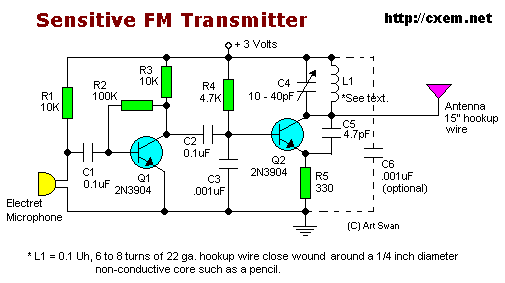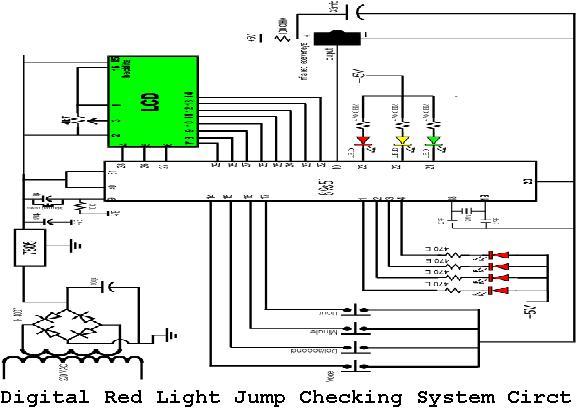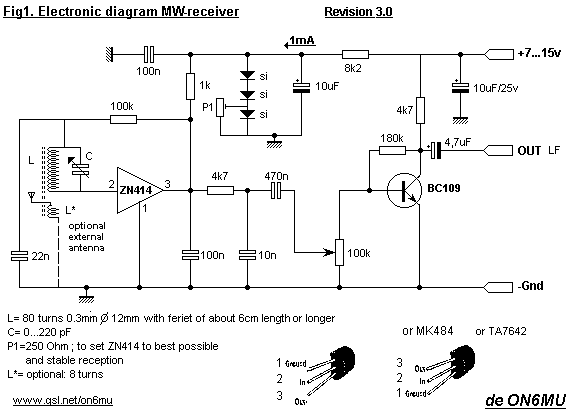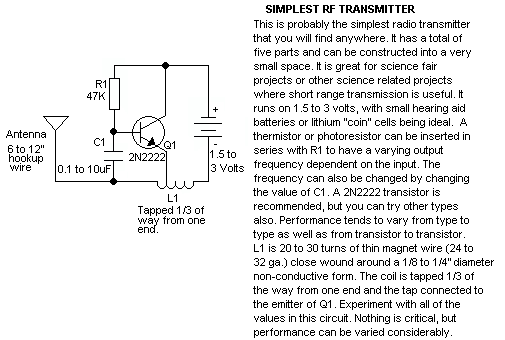
Ridiculously Simple AVR AM Radio Transmitter
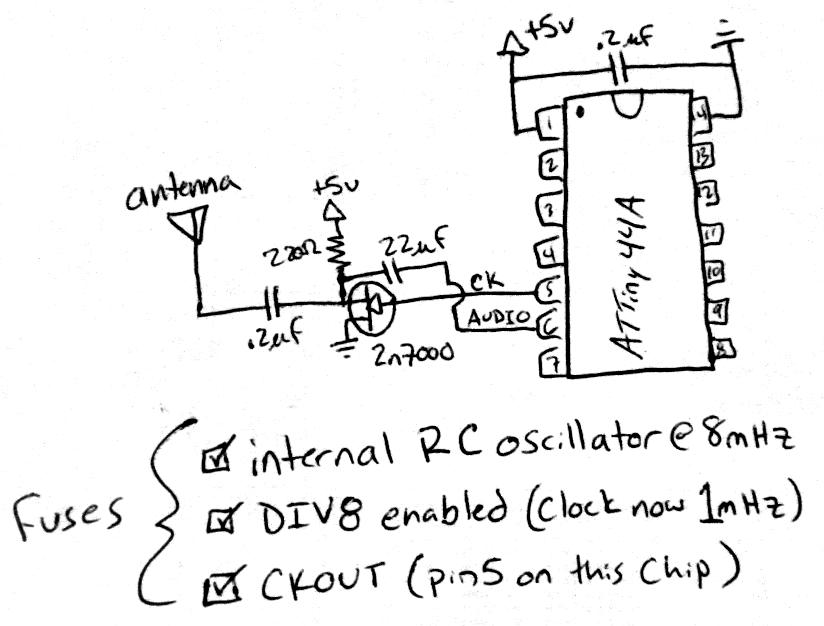
Create a rapid transmitter/receiver pair that can be found in most households. An AM or FM radio system is suitable since it is widely accessible. The design focuses on generating the required radio signal and modulating it effectively. After exploring several LC oscillator designs, the use of RC oscillators integrated into microcontrollers was considered. An ATMEL AVR microcontroller (specifically the ATTiny44A) was selected, which features an 8MHz RC oscillator that can be divided down to 1MHz and output through a CKOUT pin, all configurable with a few hardware fuses. Commercial AM radio stations operate between 0.52 and 1.61 MHz, making a 1MHz signal ideal for this application. A prototype was built to evaluate its performance. Initial concerns about the stability of the RC oscillator for reliable audio transmission were unfounded. The circuit is straightforward: when appropriately configured, the AVR produces 5V square waves from the CKOUT pin. However, these signals are insufficiently powerful to be audible across a room, necessitating an amplification stage. A Class C amplifier using a 2N7000 N-channel MOSFET was chosen, a common approach in low-power amateur radio (QRP) applications. The configuration includes a 220-ohm resistor connected to the drain and the CKOUT pin connected directly to the gate of the MOSFET. Amplitude modulation is achieved by applying a voltage from a microcontroller pin (switched on and off rapidly) through a decoupling capacitor into the drain of the MOSFET. This setup allows for the transmission of Morse code messages easily. The potential applications are vast, as this method provides an efficient way to send audio from a microcontroller to a radio or computer. The ability to dynamically generate different audio frequencies and tones facilitates straightforward data exchange, and it is possible to modify the code to create an RTTY (Radio Teletype) or Hellschreiber transmitter.
The circuit design for this transmitter/receiver pair centers around the ATTiny44A microcontroller, which serves as the heart of the system. The microcontroller's 8MHz RC oscillator provides a stable clock source that can be divided down to generate a 1MHz signal. This frequency is advantageous as it falls within the standard AM radio band, allowing for compatibility with common radio receivers.
The output from the CKOUT pin is initially a square wave, which, while visually appealing, lacks the power needed for effective transmission. To address this, the Class C amplifier stage using the 2N7000 MOSFET is employed. The MOSFET is configured to amplify the square wave signal. The drain of the MOSFET is connected to a 220-ohm resistor, which acts as a load and helps shape the output signal. The gate of the MOSFET is driven by the CKOUT output, allowing the square wave to control the MOSFET's switching.
To modulate the output signal, a microcontroller pin is used to apply a varying voltage to the drain of the MOSFET through a decoupling capacitor. This modulation technique enables the transmission of Morse code by rapidly turning the signal on and off, creating distinct dots and dashes. The simplicity of this design allows for easy implementation and testing, making it ideal for hobbyists and those new to radio transmission.
It is important to note that while this circuit demonstrates the principles of amateur radio transmission, there are legal limitations regarding power levels and frequency usage. Exceeding certain power thresholds can interfere with licensed broadcasters and may result in regulatory actions from the FCC. Therefore, caution should be exercised when using this circuit, particularly regarding the output power and frequency harmonics generated by the square wave signal.Create a rapid transmitter/receiver pair that anyone would have around their house. I decided that AM or FM radio would be good since everyone can receive that, and pondered how best to generate the necessary radio signal and modulate it appropriately. After a few LC oscillator designs, I thought about the RC oscillators built into most micro-controllers.
I grabbed an ATMEL AVR I had on hand (an ATTiny44A) and checked the datasheet. It had an 8MHz RC oscillator, which could be divided-down to 1MHz, and output on a CKOUT pin all configurable with a few hardware fuses! Note that commercial AM radio stations are between 0. 52 and 1. 61 MHz, so a 1MHz signal would be smack-dab in the middle of our radio dial! I had to build a prototype to see how well it would work. Once concern was that the RC oscillator wouldn`t be stable enough to produce reliable audio boy was I wrong!
The circuitry is textbook simple. Appropriately configured, the AVR generates 5V square waves from its CKOUT pin. Although a pretty shape, they`re not powerful enough on their own to be heard across a room, so I needed an amplifier stage. A class C amplifier provided by a 2n7000 is commonly done in the low power amateur radio (QRP) community, so I went with it.
A 2n7000 N-channel MOSFET with a 220-ohm resistor on the drain and the CKOUT directly into the gate did a fine job (I`ve used this design for 10MHz QRSS transmitters before), and I was able to modulate its amplitude by feeding the voltage from a MCU pin (turned on/off rapidly) through a decoupling capacitor into the drain of the MOSFET. I couldn`t have asked for a simpler result! This code sends a message in Morse code. It seems too easy! Applications are endless, as this is one heck of an easy way to send audio from a micro-controller to a radio, and possibly to a computer.
Morse code is easy, and since we have the ability to dynamically generate different audio frequencies and tones, data exchange is easy too! Nothing`s stopping you from adding the code to turn this into a RTTY (or Hellschreiber ) transmitter.
// designed for and tested with ATTiny44A #include #define F_CPU 1000000UL #include #include void beep(){ for(char i=50;i;i-){ DDRA|=_BV(PA7);_delay_ms(1); DDRA&=~_BV(PA7);_delay_ms(1); } } void rest(){_delay_ms(100);} void dot(){beep();rest();} void dash(){beep();beep();beep();rest();} void space(){rest();rest();} void space2(){space();space();} int main(){ DDRA|=_BV(PA7); for(;){ dot();dot();dot();space(); // S dash();dot();dash();dot();space(); // C dash();dash();dash();space(); // O dash();space(); // T dash();space(); // T space2(); dot();dash();dot();space(); // R dash();dash();dash();space(); // O dash();dot();dash();dot();space(); // C dash();dot();dash();space(); // K dot();dot();dot();space(); // S _delay_ms(1000); // silence } return 0; } THIS IS ILLEGAL to do if you exceed a certain amount of power because you`re stepping on legitimate commercial broadcasters and will have to deal with the FCC. Additionally, you are transmitting on more frequencies than the primary frequency because the signal is heavy in odd harmonics.
This means a 1 MHz transmitter, producing square waves, will generate tones on 1, 3, 5, 7 MHz, etc. Don`t do this with much power! Heck, you probably shouldn`t do it at all ;-) Scott Harden has had a lifelong passion for computer programming and electrical engineering, and recently has become interested in its relationship with biomolecular sciences. He has run a personal website since he was 15, which has changed names from HardenTechnologies. com, to KnightHacker. com, to ScottIsHot. com, to its current SWHarden. com. Scott has been in college for 10 years, with 3 more years to go. He has an AA in Biology (Valencia College), BS in Cell Biology (Union University), MS in Molecular Biology and Mic
🔗 External reference
The circuit design for this transmitter/receiver pair centers around the ATTiny44A microcontroller, which serves as the heart of the system. The microcontroller's 8MHz RC oscillator provides a stable clock source that can be divided down to generate a 1MHz signal. This frequency is advantageous as it falls within the standard AM radio band, allowing for compatibility with common radio receivers.
The output from the CKOUT pin is initially a square wave, which, while visually appealing, lacks the power needed for effective transmission. To address this, the Class C amplifier stage using the 2N7000 MOSFET is employed. The MOSFET is configured to amplify the square wave signal. The drain of the MOSFET is connected to a 220-ohm resistor, which acts as a load and helps shape the output signal. The gate of the MOSFET is driven by the CKOUT output, allowing the square wave to control the MOSFET's switching.
To modulate the output signal, a microcontroller pin is used to apply a varying voltage to the drain of the MOSFET through a decoupling capacitor. This modulation technique enables the transmission of Morse code by rapidly turning the signal on and off, creating distinct dots and dashes. The simplicity of this design allows for easy implementation and testing, making it ideal for hobbyists and those new to radio transmission.
It is important to note that while this circuit demonstrates the principles of amateur radio transmission, there are legal limitations regarding power levels and frequency usage. Exceeding certain power thresholds can interfere with licensed broadcasters and may result in regulatory actions from the FCC. Therefore, caution should be exercised when using this circuit, particularly regarding the output power and frequency harmonics generated by the square wave signal.Create a rapid transmitter/receiver pair that anyone would have around their house. I decided that AM or FM radio would be good since everyone can receive that, and pondered how best to generate the necessary radio signal and modulate it appropriately. After a few LC oscillator designs, I thought about the RC oscillators built into most micro-controllers.
I grabbed an ATMEL AVR I had on hand (an ATTiny44A) and checked the datasheet. It had an 8MHz RC oscillator, which could be divided-down to 1MHz, and output on a CKOUT pin all configurable with a few hardware fuses! Note that commercial AM radio stations are between 0. 52 and 1. 61 MHz, so a 1MHz signal would be smack-dab in the middle of our radio dial! I had to build a prototype to see how well it would work. Once concern was that the RC oscillator wouldn`t be stable enough to produce reliable audio boy was I wrong!
The circuitry is textbook simple. Appropriately configured, the AVR generates 5V square waves from its CKOUT pin. Although a pretty shape, they`re not powerful enough on their own to be heard across a room, so I needed an amplifier stage. A class C amplifier provided by a 2n7000 is commonly done in the low power amateur radio (QRP) community, so I went with it.
A 2n7000 N-channel MOSFET with a 220-ohm resistor on the drain and the CKOUT directly into the gate did a fine job (I`ve used this design for 10MHz QRSS transmitters before), and I was able to modulate its amplitude by feeding the voltage from a MCU pin (turned on/off rapidly) through a decoupling capacitor into the drain of the MOSFET. I couldn`t have asked for a simpler result! This code sends a message in Morse code. It seems too easy! Applications are endless, as this is one heck of an easy way to send audio from a micro-controller to a radio, and possibly to a computer.
Morse code is easy, and since we have the ability to dynamically generate different audio frequencies and tones, data exchange is easy too! Nothing`s stopping you from adding the code to turn this into a RTTY (or Hellschreiber ) transmitter.
// designed for and tested with ATTiny44A #include
This means a 1 MHz transmitter, producing square waves, will generate tones on 1, 3, 5, 7 MHz, etc. Don`t do this with much power! Heck, you probably shouldn`t do it at all ;-) Scott Harden has had a lifelong passion for computer programming and electrical engineering, and recently has become interested in its relationship with biomolecular sciences. He has run a personal website since he was 15, which has changed names from HardenTechnologies. com, to KnightHacker. com, to ScottIsHot. com, to its current SWHarden. com. Scott has been in college for 10 years, with 3 more years to go. He has an AA in Biology (Valencia College), BS in Cell Biology (Union University), MS in Molecular Biology and Mic
🔗 External reference
